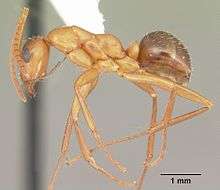Formica pallidefulva
| Formica pallidefulva | |
|---|---|
 | |
| Formica pallidefulva worker | |
| Scientific classification | |
| Kingdom: | Animalia |
| Phylum: | Arthropoda |
| Class: | Insecta |
| Order: | Hymenoptera |
| Family: | Formicidae |
| Subfamily: | Formicinae |
| Genus: | Formica |
| Species: | F. pallidefulva |
| Binomial name | |
| Formica pallidefulva Latreille, 1802[1] | |
| Synonyms[1] | |
| |
Formica pallidefulva is a species of ant found in North America. It is a red to dark brown ant with a shiny body and varies in shade across its range. Colonies of this ant are found in a variety of habitats where they excavate underground nests with galleries and chambers. In some parts of its range, the nests may be raided by slave-making ants, most notably Formica pergandei and Polyergus montivagus.
Description
The workers of Formica pallidefulva are very similar in appearance to those of Formica incerta but are more glossy. They have little pubescence on the mesosoma and the gaster has only a scant covering of short hairs. This ant is very variable in colour. Northern populations are deep brownish-black but southern types are bright, coppery yellow, and there are various intermediate colour combinations in the central part of its range. Even among the workers of a colony, there is a considerable degree of variation in colouring but none of these variations seems to be taxonomically significant.[1]
Distribution and habitat
Formica pallidefulva is found in eastern North America. Its range extends from southeastern Canada and the eastern United States westwards to the Great Plains and the foothills of the Rocky Mountains from Wyoming to New Mexico. It is a common species and is found in a variety of habitats including grassland, woodland, forest, rough ground, lawns, parks and campuses.[1]
Behaviour
The nest of Formica pallidefulva is excavated below ground and consists of one or more horizontal galleries near the surface from which descend one or two vertical galleries about 1 cm (0.4 in) in diameter and up to 60 centimetres (24 in) long. A typical nest has about 18 chambers in which the ants live, radiating off the horizontal and vertical galleries and measuring about 4 by 2.5 cm (2 by 1 in), each having a level floor and domed roof. The entrance is inconspicuous and up to 2.5 cm (1 in) in diameter, sometimes in open ground and sometimes concealed. About a quarter of the nests have two entrances. There is not usually a mound on the surface above the nest but a newly excavated entrance may be surrounded by a halo of ejected soil.[2] In forested areas, nests may be dug under bark on old tree stumps or in rotten logs, and in grassland, a small mound may be formed above a nest in or beside a clump of grass.[1]
Formica pallidefulva is diurnal and worker ants spend the night in the nest and emerge from the nest in the morning to forage. In many nests, about three quarters of the larvae are not enclosed in a cocoon when they pupate, but the proportion varies from nest to nest and from year to year. Male and female alates emerge from larvae that have overwintered and pupated in late spring. They fly in late summer, having emerged from the nest a few at a time, and launched themselves into the air individually. The flights generally take place in the morning at about the time at which the sun reaches the nest. When a newly fertilised female alights, she breaks off her wings and excavates a small chamber in which to lay her eggs. She remains there, feeding the larvae that hatch on regurgitated food and the first batch of workers is stunted through lack of adequate nourishment. More eggs are laid by the queen and reared by the new workers which also go out to forage and enlarge the nest. Nests generally contain a single queen and grow in size over the years. No reproductives are produced until the colony is large and mature enough. In the event that a nest site is inadequate for further colony development, a new site can be found and the colony can migrate, the workers carrying the larvae and pupae.[2]

The nests of Formica pallidefulva are sometimes raided by the slave-making ant Polyergus montivagus.[1] The raiding ants are known as slavemaker or dulotic ants and the raided ones as slaves or hosts, and the pupae and larvae of the host are carried off.[1] They are taken back to the dulotic nest and reared there by host ants already present in the nest. When they emerge from their pupae they join the mixed colony's workforce.[1]
References
External links
 Media related to Formica pallidefulva at Wikimedia Commons
Media related to Formica pallidefulva at Wikimedia Commons